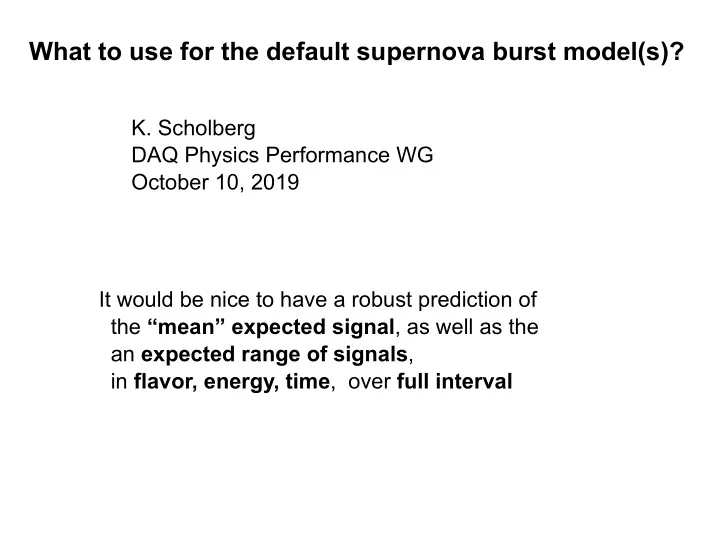

What to use for the default supernova burst model(s)? K. Scholberg DAQ Physics Performance WG October 10, 2019 It would be nice to have a robust prediction of the “mean” expected signal , as well as the an expected range of signals , in flavor, energy, time , over full interval
Issues with selecting default model: • there are very few models based on sophisticated supercomputer sims that go out to even ~10 secs • there may be interesting stuff happening later • the ones that exist vary by ~order of magnitude in many features (flavor-time-energy) • some variation is expected due to “truth” variations , (progenitor mass, composition, etc.) • other variation is due to different assumptions in the modeling (2D vs 3D, EOS, transport, magnetic fields,...) • we have some model databases • but they are primarily “collections of anecdotes” • desirable to have a frequency distribution
What we have in hand (can apply MSW oscillations under NO/IO) Model Time dependence? Frequency Comments distribution? Generic pinched spectrum No Can choose any parameters Livermore Yes, to ~10 s No, single model Deprecated, but used a lot (integrated over time in in the past Snowglobes) GKVM Yes, to ~10 s No, single model Collective effects, but (integrated over time in single example Snowglobes) Garching Yes, to 10 s No, single model Used for most plots so far (a bit weird, low flux) Huedepohl database Yes, to ~10 s No, collection of Detailed sim anecdotes Nakazato database Yes, to ~10 s No, collection of Detailed sim, no explicit anecdotes pinching Burrows database Only neutronization burst No, collection of anecdotes O’Connor compactness No, integrated over time Yes, based on distribution compactness distribution Strange star formation Out to ~100 s No, unknown rate Poor spectral info
“Garching model”: used for these plots But it’s a possibly a non-standard kind of supernova (the only complete time-dependent info available until recently)
More extensive models we’ve been working with: see Vitor Luzio’s collaboration meeting talk (he’s showing the first ~1 s, but many go to ~10 s) V. Luzio
V. Luzio (Some of these may be unreliable...)
V. Luzio 40 kton
V. Luzio
An attempt to find a sensible probability distribution : for signals: see Crystal Burgos collaboration meeting talk • find time-integrated spectrum/flux vs compactness • use compactness & distance distributions to find distribution of neutrino fluxes But this doesn’t have time profile information...
We shouldn’t forget that weird stuff may happen: AJ Roeth Jan 2019 collab meeting talk on strange star formation Events out to ~100 sec with specific time profile
What to use? at the moment, can’t have everything... - Single model: Garching Low-flux, so maybe conservative - Huedepohl database : citable, extensive, BUT some models may be less reliable (?), and no indication of relative probabilities (spectrum vs time histograms are available) /pnfs/dune/persistent/users/schol/histos - We should not design anything too dependent on model assumptions, because there may be surprises - IMO if we tune DAQ/trigger such that MO matters, it’s too tuned
Recommend
More recommend